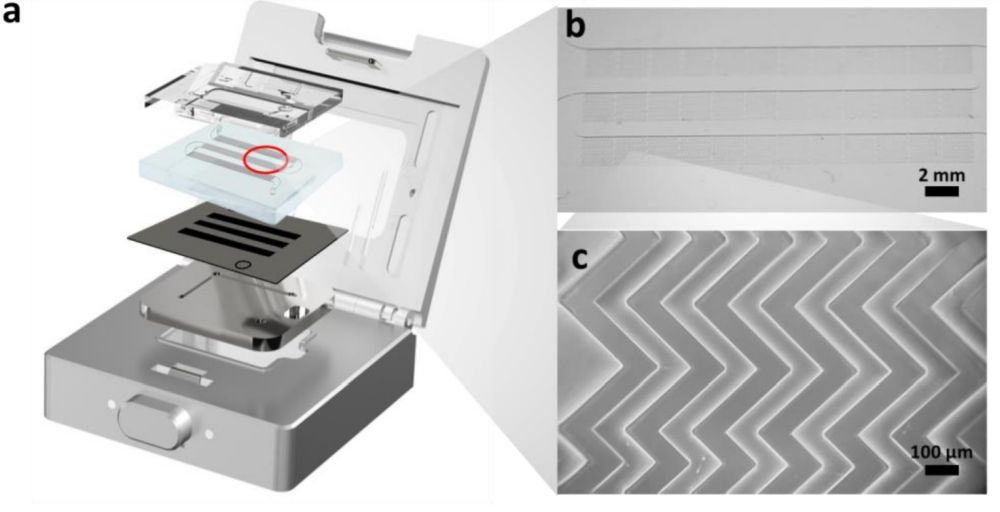
25 Sep Early diagnosis of primary liver cancer: A microfluidic approach
Hepatocellular carcinoma (HCC) is one of the most common types of cancer in the liver. HCC initiates in the liver which makes it a primary liver cancer as opposed to the secondary liver cancers that start in another location and then spread over. Indeed, similar to many other cancer types, early detection of HCC can significantly increase the effectiveness of therapeutic interventions. The emergence of microfluidics and its promises in the analysis of low concentrations of target biomolecules in small volumes of analytes opened up a window of opportunity in oncology for early diagnosis of cancer. Among the conventional liquid biopsy elements (i.e. extracellular vesicles, circulating tumor cells, and circulating tumor DNA), extracellular vesicles (EVs) are present in the bodily fluids at relatively early stages and therefore can be a good target for early diagnosis.
Researchers, in a study published in Nature Communications, have recently interfaced a microfluidic chip with nanostructured substrates to develop a platform for early diagnosis of HCC. This microfluidic device, called EV Click Chips, aims at purifying the extracellular vesicle content of the patient’s bodily fluids.
“In this study, we have successfully developed and validated a HCC EV purification system, i.e., EV Click Chips, by uniquely integrating several coherent strategies including covalent chemistry-mediated EV capture/release, a multimarker antibody cocktail, nanostructured substrates, and a PDMS chaotic mixer, promising rapid and effective purification of HCC EVs with intact mRNA cargo.”, the authors explained.
Design and working principle of the chip
A major issue with extracellular vesicles is the high background noise. EVs are employed by the cells for a wide range of applications. On the other hand, not all of the EVs are cancer-related. Therefore, it is imperative to distinguish between tumor-shed and irrelevant EVs. For this, the group devised a multimarker cocktail of antibodies targeting three surface markers (EpCAM, ASGPR1, CD147) coupled with downstream molecular profiling the HCC EV-derived mRNAs.
The microfluidic chip is composed of a patterned Si nanowire substrate (SiNWS) functionalized with tetrazine to capture the EVs that were already mixed with the multimarker antibody cocktail. The nansostructured substrate increased the surface area significantly compared to a flat substrate (~30 times) which in turn enhances the exposure of the labelled EVs. This is dramatically enhanced by embedding a microfluidic herringbone structure on the roof of each microchannel. The herringbone structure causes a microvortex in the microchannels and passively stirs the flow to even further enhance the capture efficiency of EVs. Subsequently, the EVs are released from the microfluidic device by a disulfide cleavage agent for downstream analysis and droplet digital PCR (RT-ddPCR).

Microfluidic chip for isolation of cancer-specific extracellular vesicles. Herringbone structures on the roof of the microchannels cause a microvortex in the chip to enhance mixing. Reproduced under Creative Commons Attribution 4.0 International License. Sun et al., Nature Communications, 2020.
The microfluidic platform was then tested with 158 plasma samples from HCC patients and a control group which led to highly efficient isolation of HCC EVs with minimal background noise. RT-ddPCR of the purified EVs resulted in quantifying 10 mRNA markers specific to HCC patients.
“Perhaps most importantly, our HCC EV-based mRNA assay displayed high sensitivity and superior performance in distinguishing early-stage HCC (BCLC Stage 0-A, or within Milan Criteria, or within UNOS DS Criteria) from at-risk liver cirrhotic patients, with the potential to allow for the detection of HCC in earlier stages when curative intent treatments are amenable. Our streamlined HCC EV-based mRNA assay holds great promise to significantly augment the ability of current HCC diagnostic modalities for early detection of HCC.”
Read the original article: Purification of HCC-specific extracellular vesicles on nanosubstrates for early HCC detection by digital scoring

Pouriya Bayat
Pouriya is a microfluidic production engineer at uFluidix. He received his B.Sc. and M.A.Sc. both in Mechanical Engineering from Isfahan University of Technology and York University, respectively. During his master's studies, he had the chance to learn the foundations of microfluidic technology at ACUTE Lab where he focused on designing microfluidic platforms for cell washing and isolation. Upon graduation, he joined uFluidix to even further enjoy designing, manufacturing, and experimenting with microfluidic chips. In his free time, you might find him reading a psychology/philosophy/fantasy book while refilling his coffee every half an hour. Is there a must-read book in your mind, do not hesitate to hit him up with your to-read list.


